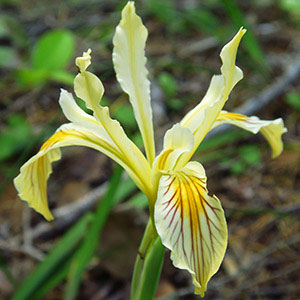Iris savannarum
Iris bracteata
prairie iris, savanna iris
Siskiyou iris
greenish, freely branching, forming large, open clumps, 2–2.5 cm diam., fleshy, with fibrous bases of old leaves not covering rhizome but persisting on ringlike scars.
sheathed with old leaf bases, slender, 0.6–0.9 cm diam.;
roots few, fibrous.
1-branched, solid, 3–10 dm.
simple, solid, 1.5–3 dm.
basal usually dying back shortly after anthesis, blade bright green, 6–10 dm × 0.8–2 cm, sometimes glaucescent;
cauline with blade elongate, linear-attenuate, 15–20 cm, exceeding flowers.
basal with abaxial surface of blades deep glossy green on one side of fan, light yellow-green on other side, pink or red-tinged basally, strongly ribbed, 4–6 dm × 0.8–1 cm, rigid, margins not thickened;
cauline 3–6, imbricated, closely sheathing stem ca. 2/3 length, spreading distally, bractlike, blade inflated, often shorter than basal leaves.
1–3-flowered, branch units 1–2-flowered;
spathes lanceolate, subequal or unequal, apex acute;
outer 8–10 cm, herbaceous, margins scarious;
inner 6–9 cm, completely scarious.
simple, units 1–2-flowered;
spathes closed tightly around pedicel and ovary, lanceolate, 5.2–9 cm × 6–8 mm, subequal, herbaceous, margins scarious, apex acuminate.
perianth blue to blue-violet (white in forma albispiritis);
floral tube funnelform, 1.2–1.5 cm;
sepals blue or pale violet with flecks of white and lines of deeper blue on either side of ridge, spatulate, elliptic to ovate, 7–8 cm, apex acuminate, ridge yellow, linear, extending to about middle of limb, finely pubescent, claw light green, striated, ribbed, 1–1.2 cm;
petals erect or spreading-erect, deep blue, linear to narrowly linear-spatulate, 6–7.5 cm, base abruptly attenuate into claw, claw channeled, green with darker lines, margins pale;
ovary bluntly 3-angled, ridged at each angle and on faces between angles;
style linear-acute, 5–6 cm;
crests ovate, 1–2 cm, margins sharply and irregularly toothed;
stigmas broadly 2-lobed, margins crenate;
pedicel 1.6–2 cm.
perianth cream to buff-yellow;
floral tube 0.8–0.9 cm;
sepals with deeper yellow signal, veined with purple or brown, obovate-lanceolate, 6.5 × 2.5 cm, base gradually attenuate into wide claw;
petals narrowly oblanceolate, 7–9 × 0.8–2 cm, base gradually attenuate;
ovary nearly circular in cross section, 1.5–2.5 cm, base gradually attenuate into pedicel, apex abruptly acuminate into floral tube;
style 2.2–3 cm, crests spreading, yellow, not veined, 1.2 × 0.9–1.7 cm, margins toothed;
stigmas triangular or tongue-shaped, margins entire;
pedicel 3–6.2 cm.
ellipsoid, round in cross section, roundly 6-lobed, with 6 sharp, winglike, equally spaced ridges converging to form stout beak at apex, 6–10 cm, dehiscence loculicidal.
nearly circular in cross section, tapering abruptly at each end, 2–2.5 × 1–1.5 cm.
in 1 row per locule, brown, circular or uneven, flattened, 8–12 mm diam, very corky.
dark brown, irregular in shape, wrinkled.
= 44.
= 40.
Iris savannarum
Iris bracteata
Iris savannarum has often been included in I. hexagona, but differs in several ways. The capsules of I. hexagona are more obviously hexagonal, with smooth faces alternating with those that have two rounded lobes, whereas the capsules of I. savannarum are more rounded but with six obvious ridges, almost of winglike proportions. Iris hexagona has yellow-green leaves instead of the brighter green of I. savannarum. The leaves of I. savannarum die back after anthesis, while those of I. hexagona remain green. The flowering period of I. savannarum is almost one month earlier than that of I. hexagona in the area where both are known to grow. The sepals of I. savannarum are more acute at the apex than those of I. hexagona.
Iris savannarum has been hybridized with Iris fulva to produce I. ×cacique (J. Berry) N. C. Henderson.
(Discussion copyrighted by Flora of North America; reprinted with permission.)
Iris bracteata is limited to one county each in northern California and southern Oregon. It hybridizes with I. chrysophylla, I. douglasiana, I. innominata, I. munzii, I. purdyi, and I. tenax.
(Discussion copyrighted by Flora of North America; reprinted with permission.)


